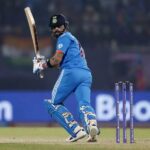
Cricket Full Score Card
Cricket Full Scorecard – This article is about recording the procedures of a cricket match. For the act of scoring runs by players, see Run (cricket).
In cricket, the scorer is the person appointed to record all the runs scored, all the wickets scored and, where applicable, the number of overs scored. In professional competitions, according to Rule 3 of the Laws of Cricket, two scorers are appointed,
Cricket Full Score Card

Scorers have no control over whether runs are scored, wickets are scored or overs are scored. This is the job of the on-field umpires to signal to the scorers in case of ambiguity, for example which runs should be given as extra rather than credited to the batsman, or when the batsman should be given a wicket. or 6. In order for the referee to know that he has received each signal, the scorers must confirm it immediately.
Live Cricket Scores & Schedule Apk For Android Download
Although it is possible to record scores using plain paper, shooters often use pre-printed score books, which are available on the market in many different styles. Simple scorebooks allow you to record each batsman’s runs, his score and how he was dismissed, the bowlers’ analysis, the team score and the score after the fall of each wicket. More sophisticated scorebooks allow more details and other statistics to be recorded, such as the number of balls faced by each batsman. Scorers sometimes also create their own score sheets, adapted to their techniques, and some use colored PS to highlight actions such as wickets, or to distinguish the actions of different batsmen or bowlers. From a modern scorecard it is often possible to determine the time at which everything happened, who bowled the ball for each over, which batsman faced the ball, whether the batsman left the ball, whether he played and failed, or f ‘which direction the batsman hit the ball and if the runs were on the spot. he won Sometimes details of events between deliveries or incidental details such as the weather are recorded.
In the old days, runs scored were sometimes simply recorded by cutting notches on a stick – which is where the slang term “notches” for “runs” comes from. However, scoring runs in the modern game has become a specialisation, especially in international and domestic cricket competitions. Although in the Laws of Cricket the role of scorers is clearly defined as simply recording runs, wickets and overs and constantly checking the accuracy of their records with each other and with the umpires, in practice r -the role of the modern scorer is complicated by other requirements. . For example, cricket authorities often need information on matters such as the pace at which teams bowled. The media also ask for information about records, statistics and averages. In many important matches, unofficial scorers record scores for television broadcasts and print journalists, allowing the official scorers to concentrate without interruption. In the glish county game, the scorers also record scores on a computer, which updates the central server to meet the demands of the online press so that the scores are as up-to-date as possible.
Some cricket statisticians who unofficially record scores for the print and broadcast media have become quite famous, such as Bill Frindall, who scored for the BBC Radio Messenger team from 1966 to 2008, and Jo King.
The manual method uses a scorecard and p. The scorecard is commonly called the Book. Using the book, the scorer fills in two main sections for each ball: bowling analysis and batting analysis. Each section helps you track the number of balls bowled in an over, any additions (such as wides and no-balls), and any wickets (or dismissals). At point d of each over, the scorer can complete an analysis of the overs, giving the score at point d over, the number of wickets lost, any bets placed and the number of bowlers included in the analysis.
Aus Vs Ind Full Scorecard, India Vs Australia 2023 Updates
Most cricket scoring software uses a form on the front d with buttons that the scorer can press to record the number of strikes ball-by-ball. Additional features include the ability to draw a line indicating where the ball is at impact and where the ball landed. This provides additional charts that track bowling position and shot selection that can be used at a training level. However, this additional information is not part of the scorer’s main role of tracking the outcome of the match. Shooters have been known to use both methods in conjunction with each other in case their computer crashes or their batteries run out.
In addition to computer software, mobile applications are used. Most amateur tournaments use mobile apps on smartphones as they are more transparent and free, making them ideal for cricket enthusiasts as they cannot afford to spend money on standalone and customized software. Mobile apps allow cricket fans to store their scores online and also provide them with personalized statistics and charts on their own mobile devices.
ECB provides free cricket scoring software for both PC and mobile devices on the PlayCricket website.

Many other game facts are followed by cricket scorers. At a minimum, the shooter notes:
Full Scorecard: Australia V West Indies
Traditionally, the scorebook may record every ball bowled by a bowler and every ball faced by a batsman, but not necessarily which batsman faced which ball. Linear scoring systems were developed in the early 20th century by John Atkinson Padlington, Bill Ferguson and Bill Frindall to track each bowler’s batted balls. Another early method of recording the number of balls hit and runs scored by each batsman against each bowler was developed by the Australian pacer J.G. Jackschon in the 1890s, using a separate note attached to the main results report.
More details are often recorded, such as the batsman, the number of balls bowled and the number of minutes batted. Sometimes charts are prepared (the so-called cartwheels) showing which part of the field was hit by each batsman’s spot shot (showing the batsman’s favorite places to hit the ball).
Technology like Hawk-Eye allows for more detailed analysis of the bowler’s performance. For example, a hive chart shows where the bowler’s balls hit the batsman (high, low, wide, on off stump, etc.), while a pitch map shows where the bowler hit the balls (to short lengths, good or whole). Both charts can also show the scores of these balls (dots, runs, boundaries or wickets)
A cricket scorer usually marks a dot on the scorecard in the event of a legal delivery with no wickets scored or runs scored (hence the term “dotted ball”), where conventional runs are scored, the scorecard a score is marked by the number of runs scored in that delivery.
Cricket Match Scorecard
The conventional scoring notation for width is a uniform cross (similar to a referee standing with his arms outstretched, indicating width).
If the batsman misses a wide ball or the ball reaches the boundary for 4, a dot is added to each corner for each bye played, usually in the top left, top right, of down on the left and finally with all 4 corners.
If the batsman hits the stump with the bat or the wicketkeeper hits it, the batsman is out and the letter “W” is added to the wide “cross” symbol.

If a batsman runs out while giving a bye to a wide delivery, the number of runs completed will be shown as dots and the letter “R” will be added in the corner to indicate an incomplete run.
Nepal Vs Pakistan Live Score Asia Cup 2023: Follow The Match Updates Here
The conventional notation for the absence of a sphere is a circle. If a batsman hits the ball and makes runs, the runs are scored inside the circle. In practice, it is easier to write a number by circling it.
If a no-ball delivery escapes the keeper and the batsman runs for a bye, or the ball reaches the boundary for 4 overs, each such bye is marked with a dot inside a circle. Again, it is easier to circle the dots. These extra runs are charged as no balls against the bowler and not as “field” extras (field extras are bye or bye).
The conventional notation for a single baje is a triangle with a horizontal edge at the base and a point at the apex. If more than one Adieu is received, the number obtained is written in a triangle – in practice it is easier to write the number and draw a triangle around it.
The conventional notation for a one-legged farewell is a triangle with a point at the base and a horizontal edge at the top (an inverted farewell symbol). If there is more than one bye, the number obtained is written in a triangle – in practice it is easier to write the number and draw a triangle around it.
Live Match Blog
In addition to the information stored on a detailed scorecard, there are special ways to summarize and present the ongoing match and the overall result of the match.
While the innings is
Cricket score card template, full cricket score, cricket full score board, cricket score card, ipl cricket score card, cricket score, free cricket score card, cricket score card today, cricket buzz live score card, cricket online score card, darts cricket score card, live score card cricket




